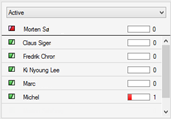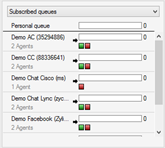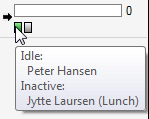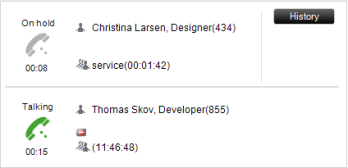In Zylinc Service Center, agents have the tools to resolve many types of telephone, e-mail and chat inquiries themselves.
If you can't resolve an inquiry, you can easily transfer the inquiry to the right person based on the Service Center calendar and search features, which help you quickly search for individuals across the entire organization, based on skills, availability, etc.

In order to receive calls your status must be Active. You can also receive calls in Standby status, but only if the call situation gets critical.
To verify your status, select Actions > Status in the Service Center window's top menu.
Always verify with your colleagues before you change your status away from active: If you're the last agent in active status, and you then change your status to inactive or offline, the queue may automatically close, because there's no one left to answer calls. Ask your Zylinc administrator if you're in doubt.
You can receive calls in two modes: Either calls are automatically assigned to you, or you can manually select the calls that you want to answer.
To change your mode, select Actions > Mode.
For step-by-step information about how to answer and handle calls, see Handle calls in Zylinc Service Center.
For similar information about how to handle e-mail and chat inquiries, see Handle chat inquiries in Zylinc Service Center and Handle e-mail inquiries in Zylinc Service Center.
To get an overview of all agents who are online, use the Agents overview.

You can view the status and personal queue for each online agent. Information about yourself always appears first.
You can view agents' status based on colors:
![]() Idle (that is ready to answer calls)
Idle (that is ready to answer calls)
![]() Busy
Busy
![]() In wrapup
In wrapup
![]() Standby
Standby
![]() Inactive
Inactive
![]() Unreachable
Unreachable
You can filter the agents so that you only view relevant agents: In the top part of the Agents overview, select either ...
-
All
-
Active: Only display agents who are active or standby
-
Subscribed to my queues: Only display agents who subscribe to at least one queue that you also subscribe to
-
Subscribed to my queues - Active: Only display agents who are active or standby, and who subscribe to at least one queue that you also subscribe to
-
Inactive: Only display inactive agents
Your organization may not use all of the filters.
You can view the situation on your organization's queues in the Queues overview.

Queues can be divided into two: The ones that you receive inquiries from, and the ones that you don't receive inquiries from. The queues that you receive inquiries from are called your subscribed queues. If you don't receive inquiries from a queue, there are two possible explanations: Either you've actively chosen not to subscribe to it (and hence not receive inquiries from that queue), or you simply can't subscribe to it.
To select which queues you want to subscribe to, select Actions > Administer Queues in the Service Center window's top menu.
Your Zylinc administrator may have made you permanently standby on other queues than the ones that you're able to select.
Your personal queue always appears first. It shows how many inquiries wait specifically for you. Inquiries can end up in your personal queue if ...
-
another agent transfers an inquiry to you
-
one of your transfers fails
-
your system is set up to offer new inquiries this way
-
someone calls your agent phone
When you have inquiries that wait for you in your personal queue, you'll not receive inquiries from other queues until you've answered all of the inquiries that wait in your personal queue.
In the main part of the Queues overview you can view graphical representations of queues and the agents that subscribe to them.

An arrow ![]() next to each queue indicates whether you receive inquiries from the queue. If an arrow is black, you can receive inquiries. If it's gray, you can't. If you change your status to inactive, the arrow colors will remain. This way, you'll know which queues you'll receive inquiries from, when you change back to active or standby.
next to each queue indicates whether you receive inquiries from the queue. If an arrow is black, you can receive inquiries. If it's gray, you can't. If you change your status to inactive, the arrow colors will remain. This way, you'll know which queues you'll receive inquiries from, when you change back to active or standby.
For each queue, you can view ...
-
The number of agents who subscribe to the queue. A number in (brackets) indicates standby agents who aren't currently needed on the queue. Once standby agents become needed, they're counted as regular agents.
-
The number of calls waiting in the queue
 . You can determine how long calls have waited based on colors:
. You can determine how long calls have waited based on colors: Acceptable
Acceptable Waiting time has exceeded the service goal of the queue
Waiting time has exceeded the service goal of the queue
-
The status of the agents who subscribe to the queue. If many agents subscribe, you'll see an agent summary instead of individual agent icons. You can view agents' status based on colors:
 Idle (that is ready to answer calls)
Idle (that is ready to answer calls) Busy
Busy In wrapup
In wrapup Standby
Standby Inactive
Inactive Unreachable
UnreachableWhen standby agents become needed, they're displayed among the other agents on the queue, like in this example where two standby agents became needed when the only active agent went offline:


To view information about individual agents on a queue, place your pointer over the icons that represent the agents.

 Filter queues
Filter queues
You can filter the queues so that you only view relevant queues: In the top part of the Queues overview, select either ...
-
All queues
-
My queues: Only display queues that you can receive inquiries from. This can include queues that you subscribe to as well as queues that you don't subscribe to.
-
Subscribed queues: Only display queues that you subscribe to. If you're standby, this filter will display the queues that you'll receive inquiries from if your help becomes required.
Your organization may not use all of the filters.
-
The Incoming inquiries overview displays all incoming calls as well as chat and e-mail inquiries in your queues.

If you're in automatic mode, you get inquiries automatically, and all you need to do is click the Answer button in the top part of the Service Center window to answer them.
If you are in manual mode or in automatic mode with inactive status, you select the required inquiry in the Incoming inquiries overview, and then you click the Answer button.
The oldest inquiry in is selected by default, so all you need to do to answer that inquiry is to click Answer. You only need to manually select an inquiry if you wish to answer a different inquiry.
In the Waiting Time column, you can see if waiting times live up to your organization's service goals. When a new inquiry is queued, it'll slowly turn yellow after a while. If the inquiry has been waiting long enough for the service goal to be in jeopardy, it'll turn orange. If it turns completely red, the service goal has been exceeded.
Individual queues may have different service goals. Ask your Zylinc administrator if you're in doubt.
If an inquiry is displayed in bold, and all other inquiries are gray, the inquiry in bold is specifically for you. You'll typically only get such inquiries if transfers fail, or if other agents transfer them to you specifically. If you don't answer the inquiry, it'll may become available to everyone after a while, depending on how your system is configured.
Likewise, an inquiry intended specifically for another agent may become available to you and other agents if the original agent doesn't answer it. When that's the case, the inquiry will have the status Transferring (name of original agent).

In the Active inquiries overview, you can view information about your ongoing calls, chat inquiries, and e-mail inquiries. Incoming inquiries appear in the top part of the overview, and outgoing ones (for example when you call someone in order to transfer a call to them) appear in the bottom part.

You can't answer new incoming calls or e-mails while you have an active call or e-mail, but you can answer and handle multiple chat inquiries simultaneously.
See more:
To quickly find the right people in your organization, and view whether they're available, use the View people, resources, and availability. In many organizations, the Time overview also lists other resources, such as meeting rooms, projectors, etc. The Time overview provides all the information you need to be able to transfer calls to the right people and provide the best possible service.
If the Time overview contains many people and other resources, use Search to filter the Time overview according to your needs.
This is help for Zylinc version 6.0. To view Zylinc unified help for other versions, go here.
© 2021 Zylinc A/S • Disclaimer
Help version: 22 January 2021 13:21:22
Share this topic: